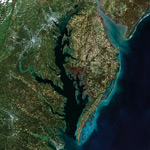
The Chesapeake Bay Foundation’s (CBF) biennial State of the Bay Report score decreased one point this year to 33, equivalent to a D+. The drop was largely due to increased pollution and poor water clarity caused by record regional rainfall.
Established in 1998, CBF’s State of the Bay Report is a comprehensive measure of the Bay’s health. CBF scientists compile and examine the best available data and information for 13 indicators in three categories: pollution, habitat, and fisheries. CBF scientists assign each indicator an index score from 1-100. Taken together, these indicators offer an overall assessment of Bay health.
Two of the 13 indicators, dissolved oxygen and Bay grasses improved. In the pollution category, toxics were unchanged, while water clarity, and nitrogen and phosphorus pollution were worse. In the habitat category, scores for Bay grasses and resource lands improved, and buffers and wetlands remained the same. In the fisheries category, scores for oysters, crabs, and rockfish remained the same, while the score for shad declined.
This year’s score is still far short of the goal to reach 40 by 2025 and ultimately a 70, which would represent a saved Bay. The unspoiled Bay ecosystem described by Captain John Smith in the 1600s, with its extensive forests and wetlands, clear water, abundant fish and oysters, and lush growths of submerged vegetation serves as the theoretical benchmark and would rate a 100 on CBF’s scale.
The Clean Water Blueprint requires the Bay jurisdictions to decrease pollution to local creeks, rivers, and the Bay. State and local governments have committed to achieve specific, measurable reductions. The states agreed to have the 60 percent of the needed programs and practices in place by 2017, and to complete the job by 2025.
Of the primary Bay states, Virginia and Maryland were close to meeting the 2017 goals but need to accelerate pollution reduction from agriculture and urban/suburban runoff. Pennsylvania continues to be far short of its goals, mostly as a result of falling behind in addressing pollution from agriculture.
The full Chesapeake Bay Foundation 2018 State of the Bay Report can be accessed at: http://www.cbf.org/document-library/cbf-reports/2018-state-of-the-bay-report.pdf
source: Chesapeake Bay Foundation
Related Information
Leave a Reply
You must be logged in to post a comment.